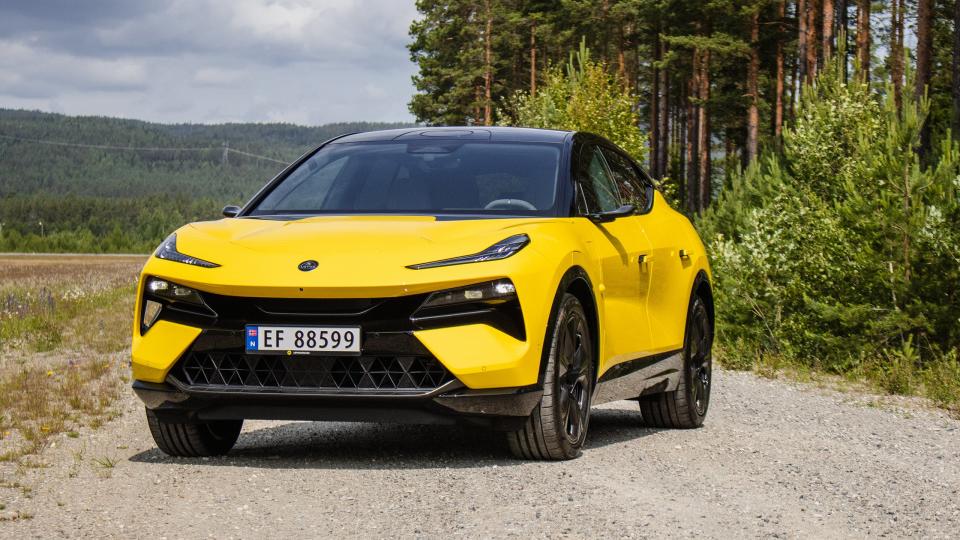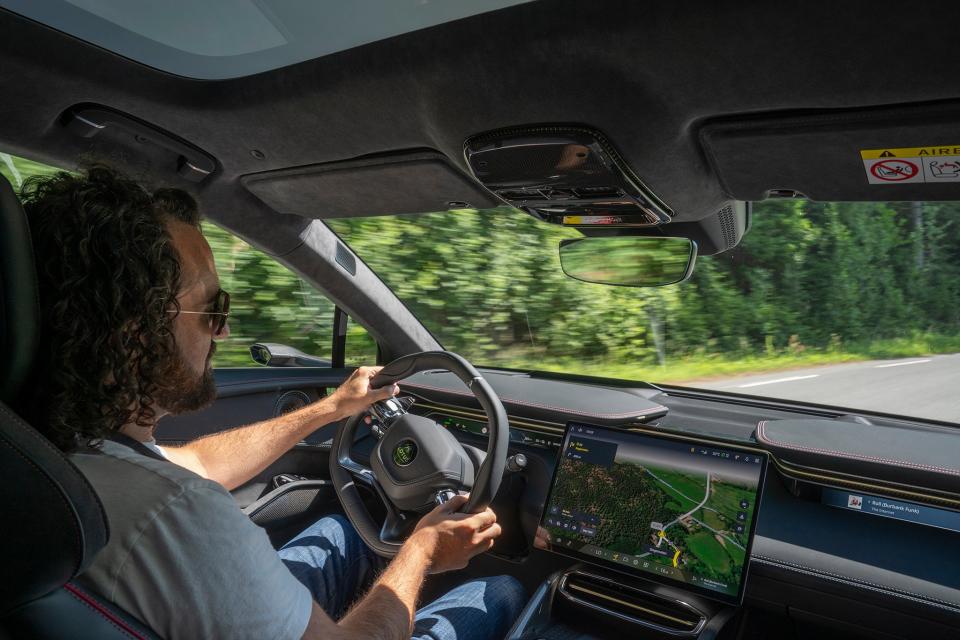2024 Lotus Eletre Review: The First Lotus SUV Leaves Lightness Behind

“I could stand here and tell you all the things we’ve done to add lightness, but come on,” Lotus spokesman Richard Yarrow chuckled. “The reality is this is the heaviest car we’ve ever built. So we’re going for a modern interpretation of lightness.”
The Lotus Eletre weighs 5,490 pounds. Or 2.73 Lotus Elises, to use a relevant metric. From the second Lotus announced it was making an electric SUV, there was no question it would break away from the thing the British brand spent 75 years building its brand on. The philosophy of lightness and simplicity cannot coexist with the reality of a mass-market EV. So the thing is nearly three tons. Glad we got that out of the way.

Because fact is, there are far more interesting things to debate about the Lotus Eletre. Essentially, what you have here is a combination of Ford’s Mustang Mach-E moment from two years ago and Porsche’s Cayenne moment from two decades ago. Taking a name that stands for engagement, tactility, and a very specific kind of performance, and for obvious financial reasons, applying it to a new paradigm where it’s impossible to port over that experience directly. Even a cynic must admit to being curious about how Lotus would try to solve that puzzle.
And it has to. After decades of lurching from crisis to crisis, Lotus is finally in a secure spot as part of the Geely Group, the Chinese auto giant that also owns Volvo and Polestar among other brands. But Geely didn’t sink billions into Lotus because it wanted to support a small, kind of weird automaker building a handful of cars a year. It’s trying to turn Lotus into a mass-market brand selling 150,000 cars a year by 2028; in 2022, it sold under 2,000.




Across a two-day test in and around Oslo, Norway, the Eletre is a very comfortable and surprisingly refined SUV leaning more luxury than performance, but it’s also a kind of confused, frenetic experience. The unconventional design, the in-your-face tech, the high power output paired with softer driving dynamics—it’s striving for something different the way old Lotuses did, but all needs a bit of editing. Unmoored from its past, Lotus is throwing a lot at the wall to figure out what modern lightness means. It just has to remember to stand for something, too.
2024 Lotus Eletre Specs
Base price: $90,000-$100,000 (est.)
Powertrain: Two permanent-magnet synchronous motors | 112-kWh lithium-ion battery | single speed transmission (two-speed rear end on the R model)
Horsepower: 603 hp | 905 hp (R)
Torque: 523 lb-ft | 726 lb-ft (R)
Curb weight: 5,490 lbs | 5,820 lbs (R)
0-60 mph: 4.4 seconds | 2.9 seconds (R)
Top speed: 160 mph | 165 mph (R)
EPA Range: Not tested yet
Cargo Space: 24.3 cubic feet | 54 cubic feet with rear seats folded
Seats: 4 or 5
Quick take: A bold leap forward with an unsteady landing, the Eletre is a compelling yet confused machine.
Eletre Brings a Whole Lot of Firsts
You can thank two things for the development of the Lotus Eletre—the ceaseless march of technology, and the cash Geely funneled into Lotus after purchasing a controlling stake in 2018 that allowed the company to develop a new EV platform for the Eletre from scratch. It’ll get adapted for future electric Lotuses, including a sleek sedan to compete with the Porsche Taycan and a two-seater sports car, but won’t get used by any other Geely brands. (Though a Lotus engineer did tell us that they’re in talks to license the platform to other OEMs, in a nice echo of the old “Handling by Lotus” deals.)
Dubbed EPA, it’s an 800-volt skateboard platform with a balanced mix of steel and aluminum components. The 112-kWh lithium-ion battery sandwiched in the middle is the same across all trims—the base, the slightly fancier Eletre S, and the high-performance Eletre R—and can charge from 10 to 80% in 20 minutes at 350 kW. (It currently uses the CCS plug, though a Lotus engineer said the company is looking at switching to Tesla’s NACS standard like so many other automakers are doing.) Range hasn’t been finalized yet, but expect it to land in the 250- to 260-mile zone for the R and 310-320 miles for the other two.







I’ll just say one thing about the design: it’s a mish-mash for sure, but looks a lot better in person than in photos. The Eletre is low, long, and riven by numerous aerodynamic passageways/speed holes to give it an impressive 0.26 drag coefficient. You can see similarities to the Emira and Evija, but it’s trying its own thing here too. The best angle is from the back—it’s the most cohesive area, the active spoiler looks the business when deployed, and the light bar is almost Chiron-like from certain angles. I think it’d look truly good with a more restrained front end, but vertically-stacked headlights are as unstoppable as electrification these days, so here we are.
All versions come with the same dual-motor AWD system too, with the permanent-magnet synchronous motors packed into one compact housing along with the controller and single-speed reduction gearing. In a twist, the Eletre R has a two-speed rear end (13.65:1 and 7.16:1) similar to the Porsche Taycan for harder launches and efficiency over 100 mph. It shifts around 87 mph with a noticeable 1-second pause, much like an older automatic transmission and not nearly as crisp as the Porsche. Lotus says that’s because overall it’s positioned more as a luxury vehicle, not a hard-edged performance car.
Ok, but: at 905 hp and 726 lb-ft, the Lotus Eletre R is actually the second-most powerful electric SUV on the market right now behind the Tesla Model X Plaid (or third if you count the Faraday Future FF 91, which we don’t). It has a track mode, 2.9-second 0-60 mph time, and a top speed of 165 mph. Even the base and S models come in strong with 603 hp and 523 lb-ft, on par with things like the BMW iX M60 (610 hp/811 lb-ft) and the upcoming Mercedes-AMG EQE53 SUV (617 hp/701 lb-ft).

Driving the Lotus Eletre
You’d think those figures would deliver extremely rapid, borderline painful launches. However, the Eletre surprises with pretty lackadaisical tip-in when you floor it from a stop; it kind of eases into it off the line before surging forward past 20 mph. Acceleration from a roll is impressive and unrelenting like it should be, but the decision to take away one of the few visceral experiences an EV can deliver—a deliberate decision to make it less intimidating to drive for the mass market, Lotus says—is another head scratcher.
Anyway, the Lotus firsts roll on in the Eletre: adjustable air suspension, active anti-roll bars, rear steering, and specially developed Pirelli P Zero PZ4 tires all deliver an excellent ride and aid in giving the heavy SUV some character in the corners. The Eletre also has Lotus’ first crack at electronic power steering, and the rack is bolted to the frame without any NVH work to introduce more feedback. Allegedly. In practice, it still feels very isolated from the road like most EPS systems and too artificially heavy in Sport mode. But it is very direct, and the rear-steer system allows for a nice amount of rotation, verging on playful through a nice set of left-right-left sweepers. You never forget the weight, though. 5,500 pounds is tough to turn on a dime.

 Yahoo Autos
Yahoo Autos 